Deck 46: Linear Programming
سؤال
سؤال
سؤال
سؤال
سؤال
سؤال
سؤال
سؤال
سؤال
سؤال
سؤال
سؤال
سؤال
سؤال
سؤال
سؤال
سؤال
سؤال
سؤال
سؤال
سؤال
سؤال
سؤال
سؤال
سؤال
سؤال
سؤال
سؤال
سؤال
سؤال
سؤال
سؤال
سؤال
سؤال
سؤال
سؤال
سؤال
سؤال
سؤال
سؤال
سؤال
سؤال
سؤال
سؤال
سؤال
سؤال
سؤال
سؤال
سؤال
سؤال

فتح الحزمة
قم بالتسجيل لفتح البطاقات في هذه المجموعة!
Unlock Deck
Unlock Deck
1/50
العب
ملء الشاشة (f)
Deck 46: Linear Programming
1
Find the minimum value of the objective function and where it occurs,subject to the indicated constraints.
Objective function:
Z = 4x + 5y
Constraints:
X ≥ 0
3x - y ≤ 9
2x + 3y ≥ 6
X + 4y ≤ 16

A)Minimum at (0,2): 10
B)Minimum at (4,3): 31
C)Minimum at (0,3): 11
D)Minimum at (3,0): 12
E)Minimum at (0,4): 20
Objective function:
Z = 4x + 5y
Constraints:
X ≥ 0
3x - y ≤ 9
2x + 3y ≥ 6
X + 4y ≤ 16

A)Minimum at (0,2): 10
B)Minimum at (4,3): 31
C)Minimum at (0,3): 11
D)Minimum at (3,0): 12
E)Minimum at (0,4): 20
Minimum at (0,2): 10
2
Select the region determined by the constraints.Then find the maximum value of the objective function (if possible)and where it occurs,subject to the indicated constraints. ?
Objective function:? ?
Constraints:? ?
A)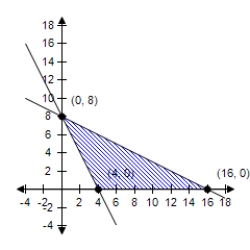 Maximum at (4,0): 28.00
Maximum at (4,0): 28.00
B)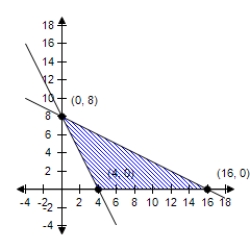 Maximum at (8,0): 2.00
Maximum at (8,0): 2.00
C)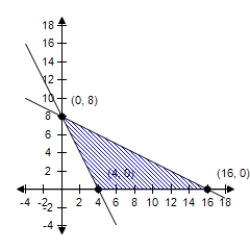 Maximum at (16,0): 112.00
Maximum at (16,0): 112.00
D)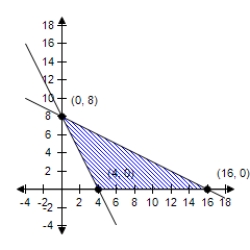 No maximum
No maximum
E)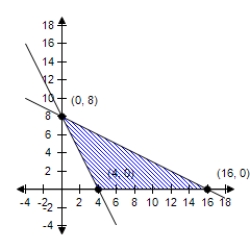 Maximum at (0,8): 1.00
Maximum at (0,8): 1.00
Objective function:? ?
Constraints:? ?
A)
 Maximum at (4,0): 28.00
Maximum at (4,0): 28.00B)
 Maximum at (8,0): 2.00
Maximum at (8,0): 2.00C)
 Maximum at (16,0): 112.00
Maximum at (16,0): 112.00D)
 No maximum
No maximumE)
 Maximum at (0,8): 1.00
Maximum at (0,8): 1.00 Maximum at (16,0): 112.00
Maximum at (16,0): 112.00 3
Find the maximum value of the objective function and where it occurs,subject to the indicated constraints.
Objective function:
Z = 4x + 5y
Constraints:
X ≥ 0
3x - y ≤ 9
2x + 3y ≥ 6
X + 4y ≤ 16
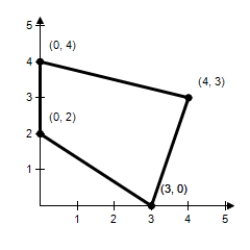
A)Maximum at (3,0): 12
B)Maximum at (3,4): 32
C)Maximum at (4,3): 31
D)Maximum at (0,4): 20
E)Maximum at (0,2): 10
Objective function:
Z = 4x + 5y
Constraints:
X ≥ 0
3x - y ≤ 9
2x + 3y ≥ 6
X + 4y ≤ 16

A)Maximum at (3,0): 12
B)Maximum at (3,4): 32
C)Maximum at (4,3): 31
D)Maximum at (0,4): 20
E)Maximum at (0,2): 10
Maximum at (4,3): 31
4
Select the region determined by the constraints.Then find the minimum value of the objective function (if possible)and where it occurs,subject to the indicated constraints.
Objective function:
Z = 9x + 8y
Constraints:
X ≥ 0
Y ≥ 0
2x + 2y ≥ 10
X + 2y ≥ 6
A)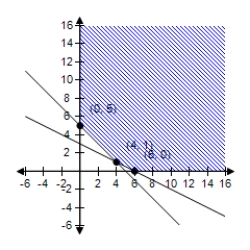 Minimum at (0,5): 40
Minimum at (0,5): 40
B)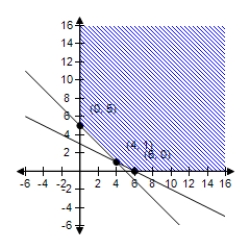 Minimum at (0,5): 41
Minimum at (0,5): 41
C)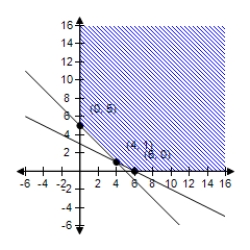 Minimum at (4,1): 44
Minimum at (4,1): 44
D)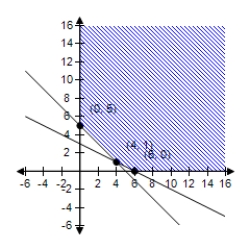 Minimum at (6,0): 54
Minimum at (6,0): 54
E)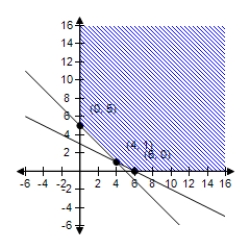 No minimum
No minimum
Objective function:
Z = 9x + 8y
Constraints:
X ≥ 0
Y ≥ 0
2x + 2y ≥ 10
X + 2y ≥ 6
A)
 Minimum at (0,5): 40
Minimum at (0,5): 40B)
 Minimum at (0,5): 41
Minimum at (0,5): 41C)
 Minimum at (4,1): 44
Minimum at (4,1): 44D)
 Minimum at (6,0): 54
Minimum at (6,0): 54E)
 No minimum
No minimum
فتح الحزمة
افتح القفل للوصول البطاقات البالغ عددها 50 في هذه المجموعة.
فتح الحزمة
k this deck
5
Find the maximum value of the objective function and where it occurs,subject to the indicated constraints.
Objective function:
Z = 9x + 5y
Constraints:
0 ≤ x ≤ 60
0 ≤ y ≤ 45
5x + 6y ≤ 420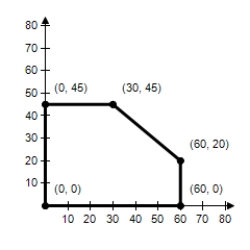
A)Maximum at (0,45): 225
B)Maximum at (0,0): 0
C)Maximum at (30,45): 495
D)Maximum at (60,20): 640
E)Maximum at (60,0): 540
Objective function:
Z = 9x + 5y
Constraints:
0 ≤ x ≤ 60
0 ≤ y ≤ 45
5x + 6y ≤ 420

A)Maximum at (0,45): 225
B)Maximum at (0,0): 0
C)Maximum at (30,45): 495
D)Maximum at (60,20): 640
E)Maximum at (60,0): 540

فتح الحزمة
افتح القفل للوصول البطاقات البالغ عددها 50 في هذه المجموعة.
فتح الحزمة
k this deck
6
Select the region determined by the constraints.Then find the minimum value of the objective function (if possible)and where it occurs,subject to the indicated constraints.
Objective function:
Z = 7x + 6y
Constraints:
X ≥ 0
y ≥ 0
5x + 2y ≤ 20
5x + y ≥ 10
A)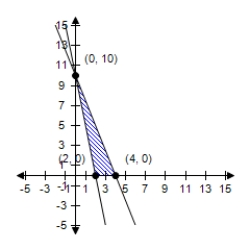 Minimum at (2,0): 14
Minimum at (2,0): 14
B)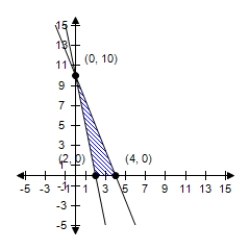 Minimum at (0,2): 15
Minimum at (0,2): 15
C)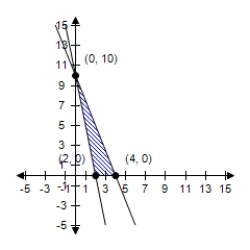 Minimum at (0,10): 60
Minimum at (0,10): 60
D)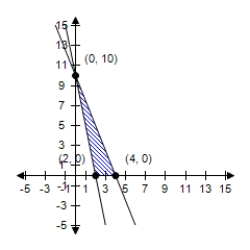 Minimum at (0,4): 29
Minimum at (0,4): 29
E)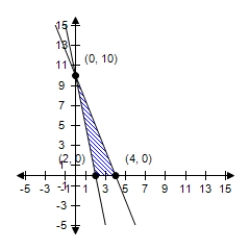 Minimum at (4,0): 14
Minimum at (4,0): 14
Objective function:
Z = 7x + 6y
Constraints:
X ≥ 0
y ≥ 0
5x + 2y ≤ 20
5x + y ≥ 10
A)
 Minimum at (2,0): 14
Minimum at (2,0): 14B)
 Minimum at (0,2): 15
Minimum at (0,2): 15C)
 Minimum at (0,10): 60
Minimum at (0,10): 60D)
 Minimum at (0,4): 29
Minimum at (0,4): 29E)
 Minimum at (4,0): 14
Minimum at (4,0): 14
فتح الحزمة
افتح القفل للوصول البطاقات البالغ عددها 50 في هذه المجموعة.
فتح الحزمة
k this deck
7
Find the maximum value of the objective function and where it occurs,subject to the indicated constraints.
Objective function:
Z = 5x + 8y
Constraints:
X ≥ 0
Y ≥ 0
X + 3y ≤ 15
4x + y ≤ 16
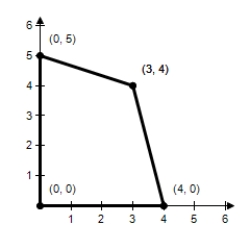
A)Maximum at (3,4): 47
B)Maximum at (4,0): 20
C)Maximum at (5,0): 44
D)Maximum at (0,5): 40
E)Maximum at (0,0): 0
Objective function:
Z = 5x + 8y
Constraints:
X ≥ 0
Y ≥ 0
X + 3y ≤ 15
4x + y ≤ 16

A)Maximum at (3,4): 47
B)Maximum at (4,0): 20
C)Maximum at (5,0): 44
D)Maximum at (0,5): 40
E)Maximum at (0,0): 0

فتح الحزمة
افتح القفل للوصول البطاقات البالغ عددها 50 في هذه المجموعة.
فتح الحزمة
k this deck
8
Select the region determined by the constraints.Then find the minimum value of the objective function (if possible)and where it occurs,subject to the indicated constraints.
Objective function:
Z = 5x + 6y
Constraints:
X ≥ 0
Y ≥ 0
X + y ≥ 8
3x + 5y ≥ 30
A) No minimum
No minimum
B)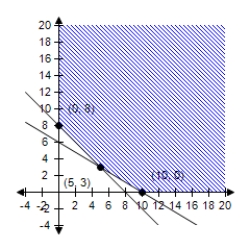 Minimum at (10,0): 50
Minimum at (10,0): 50
C)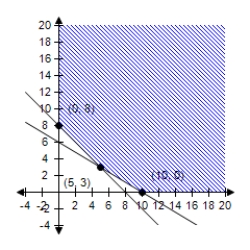 Minimum at (8,0): 49
Minimum at (8,0): 49
D)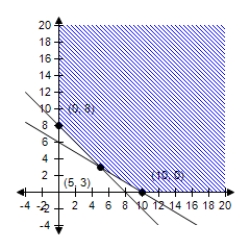 Minimum at (5,3): 43
Minimum at (5,3): 43
E)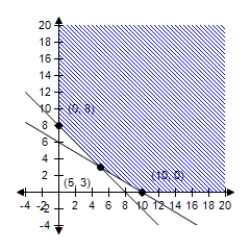 Minimum at (0,8): 48
Minimum at (0,8): 48
Objective function:
Z = 5x + 6y
Constraints:
X ≥ 0
Y ≥ 0
X + y ≥ 8
3x + 5y ≥ 30
A)
 No minimum
No minimumB)
 Minimum at (10,0): 50
Minimum at (10,0): 50C)
 Minimum at (8,0): 49
Minimum at (8,0): 49D)
 Minimum at (5,3): 43
Minimum at (5,3): 43E)
 Minimum at (0,8): 48
Minimum at (0,8): 48
فتح الحزمة
افتح القفل للوصول البطاقات البالغ عددها 50 في هذه المجموعة.
فتح الحزمة
k this deck
9
Select the region determined by the constraints.Then find the maximum value of the objective function (if possible)and where it occurs,subject to the indicated constraints.
Objective function:
Z = 3x + 2y
Constraints:
X ≥ 0
y ≥ 0
5x + 2y ≤ 20
5x + y ≥ 10
A)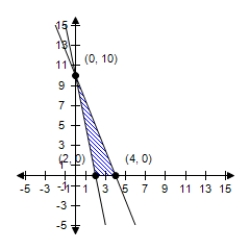 Maximum at (0,10): 20
Maximum at (0,10): 20
B)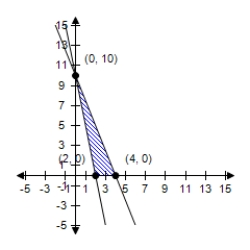 Maximum at (2,0): 6
Maximum at (2,0): 6
C)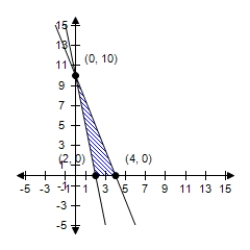 Maximum at (10,0): 13
Maximum at (10,0): 13
D) Maximum at (0,4): 7
Maximum at (0,4): 7
E)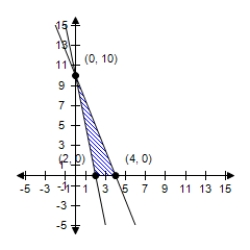 Maximum at (4,0): 12
Maximum at (4,0): 12
Objective function:
Z = 3x + 2y
Constraints:
X ≥ 0
y ≥ 0
5x + 2y ≤ 20
5x + y ≥ 10
A)
 Maximum at (0,10): 20
Maximum at (0,10): 20B)
 Maximum at (2,0): 6
Maximum at (2,0): 6C)
 Maximum at (10,0): 13
Maximum at (10,0): 13D)
 Maximum at (0,4): 7
Maximum at (0,4): 7E)
 Maximum at (4,0): 12
Maximum at (4,0): 12
فتح الحزمة
افتح القفل للوصول البطاقات البالغ عددها 50 في هذه المجموعة.
فتح الحزمة
k this deck
10
Find the maximum value of the objective function and where it occurs,subject to the constraints:
Objective function:
Z = 7x + y
Constraints:
X ≥ 0
Y ≥ 0
3x + y ≤ 15
4x + 3y ≤ 30
A)Maximum at (0,0): 0
B)Maximum at (5,0): 35
C)Maximum at (0,6): 46
D)Maximum at (6,3): 45
E)Maximum at (3,0): 21
Objective function:
Z = 7x + y
Constraints:
X ≥ 0
Y ≥ 0
3x + y ≤ 15
4x + 3y ≤ 30
A)Maximum at (0,0): 0
B)Maximum at (5,0): 35
C)Maximum at (0,6): 46
D)Maximum at (6,3): 45
E)Maximum at (3,0): 21

فتح الحزمة
افتح القفل للوصول البطاقات البالغ عددها 50 في هذه المجموعة.
فتح الحزمة
k this deck
11
Find the minimum value of the objective function and where it occurs,subject to the indicated constraints.
Objective function:
Z = 4x + 16y
Constraints:
X ≥ 0
Y ≥ 0
2x + y ≤ 12
A)Minimum at (0,0): 0
B)Minimum at (6,0): 49
C)Minimum at (0,6): 48
D)Minimum at (12,0): 192
E)Minimum at (0,12): 193
Objective function:
Z = 4x + 16y
Constraints:
X ≥ 0
Y ≥ 0
2x + y ≤ 12

A)Minimum at (0,0): 0
B)Minimum at (6,0): 49
C)Minimum at (0,6): 48
D)Minimum at (12,0): 192
E)Minimum at (0,12): 193

فتح الحزمة
افتح القفل للوصول البطاقات البالغ عددها 50 في هذه المجموعة.
فتح الحزمة
k this deck
12
Find the minimum value of the objective function and where it occurs,subject to the constraints:
Objective function:
Z = 4x + y
Constraints:
X ≥ 0
Y ≥ 0
3x + y ≤ 15
4x + 3y ≤ 30
A)Minimum at (3,0): 12
B)Minimum at (0,6): 28
C)Minimum at (3,6): 18
D)Minimum at (0,0): 0
E)Minimum at (6,3): 27
Objective function:
Z = 4x + y
Constraints:
X ≥ 0
Y ≥ 0
3x + y ≤ 15
4x + 3y ≤ 30
A)Minimum at (3,0): 12
B)Minimum at (0,6): 28
C)Minimum at (3,6): 18
D)Minimum at (0,0): 0
E)Minimum at (6,3): 27

فتح الحزمة
افتح القفل للوصول البطاقات البالغ عددها 50 في هذه المجموعة.
فتح الحزمة
k this deck
13
Find the minimum value of the objective function and where it occurs,subject to the indicated constraints.
Objective function:
Z = 4x + 7y
Constraints:
X ≥ 0
Y ≥ 0
X + 3y ≤ 15
4x + y ≤ 16
A)Minimum at (3,4): 40
B)Minimum at (0,0): 0
C)Minimum at (0,5): 35
D)Minimum at (4,3): 37
E)Minimum at (4,0): 16
Objective function:
Z = 4x + 7y
Constraints:
X ≥ 0
Y ≥ 0
X + 3y ≤ 15
4x + y ≤ 16

A)Minimum at (3,4): 40
B)Minimum at (0,0): 0
C)Minimum at (0,5): 35
D)Minimum at (4,3): 37
E)Minimum at (4,0): 16

فتح الحزمة
افتح القفل للوصول البطاقات البالغ عددها 50 في هذه المجموعة.
فتح الحزمة
k this deck
14
Select the region determined by the constraints.Then find the maximum value of the objective function (if possible)and where it occurs,subject to the indicated constraints.
Objective function:
Z = 8x + 9y
Constraints:
X ≥ 0
Y ≥ 0
X + y ≥ 8
3x + 5y ≥ 30
A)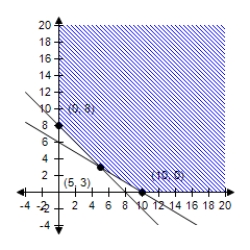 Maximum at (10,0): 80
Maximum at (10,0): 80
B)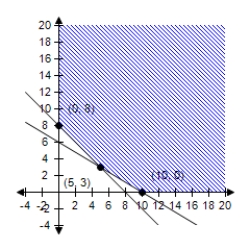 Maximum at (3,5): 68
Maximum at (3,5): 68
C)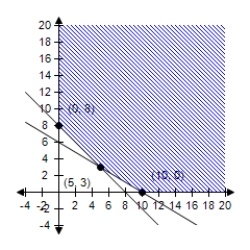 Maximum at (5,3): 67
Maximum at (5,3): 67
D)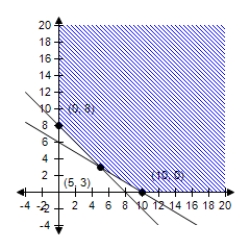 Maximum at (0,8): 72
Maximum at (0,8): 72
E)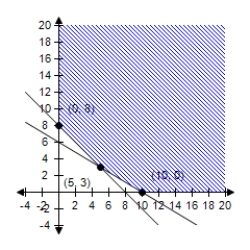 No maximum
No maximum
Objective function:
Z = 8x + 9y
Constraints:
X ≥ 0
Y ≥ 0
X + y ≥ 8
3x + 5y ≥ 30
A)
 Maximum at (10,0): 80
Maximum at (10,0): 80B)
 Maximum at (3,5): 68
Maximum at (3,5): 68C)
 Maximum at (5,3): 67
Maximum at (5,3): 67D)
 Maximum at (0,8): 72
Maximum at (0,8): 72E)
 No maximum
No maximum
فتح الحزمة
افتح القفل للوصول البطاقات البالغ عددها 50 في هذه المجموعة.
فتح الحزمة
k this deck
15
Find the maximum value of the objective function and where it occurs,subject to the indicated constraints.
Objective function:
Z = 4x + 3y
Constraints:
X ≥ 0
Y ≥ 0
X + y ≤ 4
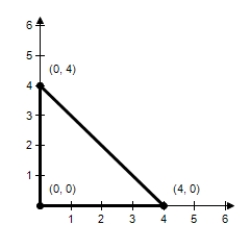
A)Maximum at (4,0): 17
B)Maximum at (0,4): 12
C)Maximum at (0,0): 0
D)Maximum at (4,0): 16
E)Maximum at (0,4): 13
Objective function:
Z = 4x + 3y
Constraints:
X ≥ 0
Y ≥ 0
X + y ≤ 4

A)Maximum at (4,0): 17
B)Maximum at (0,4): 12
C)Maximum at (0,0): 0
D)Maximum at (4,0): 16
E)Maximum at (0,4): 13

فتح الحزمة
افتح القفل للوصول البطاقات البالغ عددها 50 في هذه المجموعة.
فتح الحزمة
k this deck
16
Select the region determined by the constraints.Then find the minimum value of the objective function (if possible)and where it occurs,subject to the indicated constraints. ?
Objective function:? ?
Constraints:? ?
A)?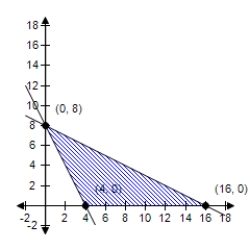 Minimum at (8,0): 3.00
Minimum at (8,0): 3.00
B)?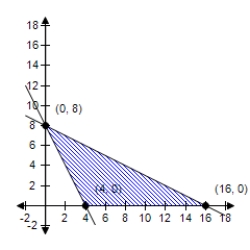 No minimum
No minimum
C)?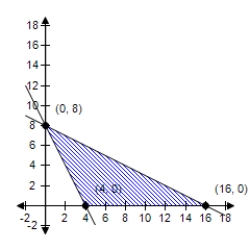 Minimum at (4,0): 28.00
Minimum at (4,0): 28.00
D)?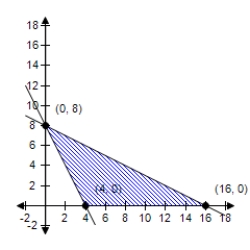 Minimum at (16,0): 112.00
Minimum at (16,0): 112.00
E)?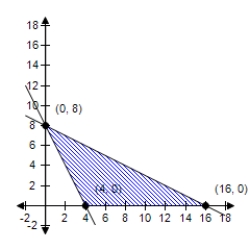 Minimum at (0,8): 2.00
Minimum at (0,8): 2.00
Objective function:? ?
Constraints:? ?
A)?
 Minimum at (8,0): 3.00
Minimum at (8,0): 3.00B)?
 No minimum
No minimumC)?
 Minimum at (4,0): 28.00
Minimum at (4,0): 28.00D)?
 Minimum at (16,0): 112.00
Minimum at (16,0): 112.00E)?
 Minimum at (0,8): 2.00
Minimum at (0,8): 2.00
فتح الحزمة
افتح القفل للوصول البطاقات البالغ عددها 50 في هذه المجموعة.
فتح الحزمة
k this deck
17
Select the region determined by the constraints.Then find the maximum value of the objective function (if possible)and where it occurs,subject to the indicated constraints.
Objective function:
Z = 8x + 7y
Constraints:
X ≥ 0
Y ≥ 0
2x + 2y ≥ 10
X + 2y ≥ 6
A)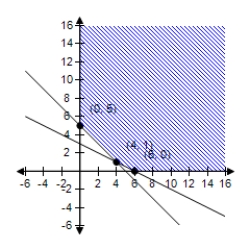 Maximum at (0,5): 35
Maximum at (0,5): 35
B)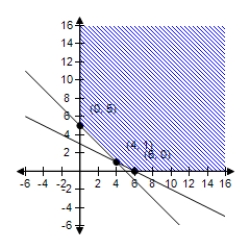 Maximum at (5,0): 36
Maximum at (5,0): 36
C)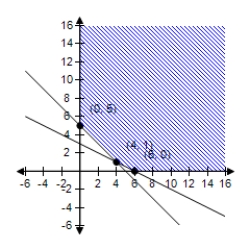 Maximum at (6,0): 48
Maximum at (6,0): 48
D)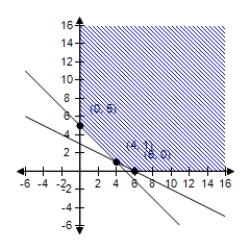 Maximum at (4,1): 39
Maximum at (4,1): 39
E)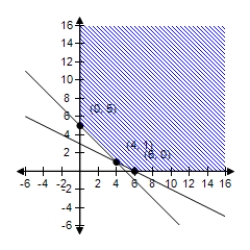 No maximum
No maximum
Objective function:
Z = 8x + 7y
Constraints:
X ≥ 0
Y ≥ 0
2x + 2y ≥ 10
X + 2y ≥ 6
A)
 Maximum at (0,5): 35
Maximum at (0,5): 35B)
 Maximum at (5,0): 36
Maximum at (5,0): 36C)
 Maximum at (6,0): 48
Maximum at (6,0): 48D)
 Maximum at (4,1): 39
Maximum at (4,1): 39E)
 No maximum
No maximum
فتح الحزمة
افتح القفل للوصول البطاقات البالغ عددها 50 في هذه المجموعة.
فتح الحزمة
k this deck
18
Find the minimum value of the objective function and where it occurs,subject to the indicated constraints.
Objective function:
Z = 5x + 4y
Constraints:
X ≥ 0
Y ≥ 0
X + y ≤ 5
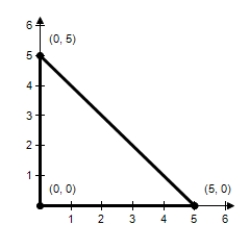
A)Minimum at (5,0): 26
B)Minimum at (0,5): 21
C)Minimum at (0,0): 0
D)Minimum at (0,5): 25
E)Minimum at (5,0): 20
Objective function:
Z = 5x + 4y
Constraints:
X ≥ 0
Y ≥ 0
X + y ≤ 5

A)Minimum at (5,0): 26
B)Minimum at (0,5): 21
C)Minimum at (0,0): 0
D)Minimum at (0,5): 25
E)Minimum at (5,0): 20

فتح الحزمة
افتح القفل للوصول البطاقات البالغ عددها 50 في هذه المجموعة.
فتح الحزمة
k this deck
19
Find the maximum value of the objective function and where it occurs,subject to the indicated constraints.
Objective function:
Z = 2x + 8y
Constraints:
X ≥ 0
Y ≥ 0
2x + y ≤ 12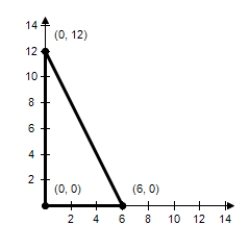
A)Maximum at (6,0): 24
B)Maximum at (12,0): 97
C)Maximum at (0,6): 25
D)Maximum at (0,12): 96
E)Maximum at (0,0): 0
Objective function:
Z = 2x + 8y
Constraints:
X ≥ 0
Y ≥ 0
2x + y ≤ 12

A)Maximum at (6,0): 24
B)Maximum at (12,0): 97
C)Maximum at (0,6): 25
D)Maximum at (0,12): 96
E)Maximum at (0,0): 0

فتح الحزمة
افتح القفل للوصول البطاقات البالغ عددها 50 في هذه المجموعة.
فتح الحزمة
k this deck
20
Find the minimum value of the objective function and where it occurs,subject to the indicated constraints.
Objective function:
Z = 10x + 4y
Constraints:
0 ≤ x ≤ 60
0 ≤ y ≤ 45
5x + 6y ≤ 420
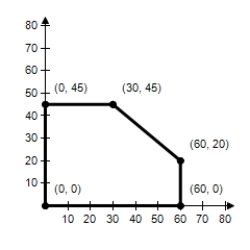
A)Minimum at (0,0): 0
B)Minimum at (60,20): 680
C)Minimum at (0,45): 180
D)Minimum at (60,0): 600
E)Minimum at (30,45): 480
Objective function:
Z = 10x + 4y
Constraints:
0 ≤ x ≤ 60
0 ≤ y ≤ 45
5x + 6y ≤ 420

A)Minimum at (0,0): 0
B)Minimum at (60,20): 680
C)Minimum at (0,45): 180
D)Minimum at (60,0): 600
E)Minimum at (30,45): 480

فتح الحزمة
افتح القفل للوصول البطاقات البالغ عددها 50 في هذه المجموعة.
فتح الحزمة
k this deck
21
The linear programming problem has an unusual characteristic.Select a graph of the solution region for the problem and describe the unusual characteristic.Find the minimum value of the objective function (if possible)and where it occurs.
Objective function:
Z = -x + 2y
Constraints:
X ≥ 0
Y ≥ 0
X ≤ 10
X + y ≤ 8
A)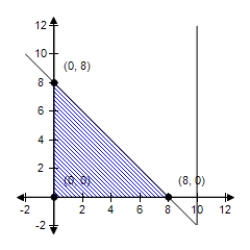 The constraint x ≤ 10 is extraneous.Minimum at (0,8): 16
The constraint x ≤ 10 is extraneous.Minimum at (0,8): 16
B)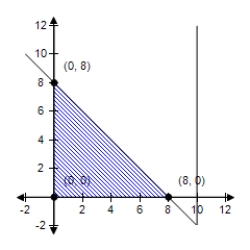 The constraint x ≤ 10 is extraneous.Minimum at (8,0): -8
The constraint x ≤ 10 is extraneous.Minimum at (8,0): -8
C) The constraint x ≤ 10 is extraneous.No minimum.
The constraint x ≤ 10 is extraneous.No minimum.
D)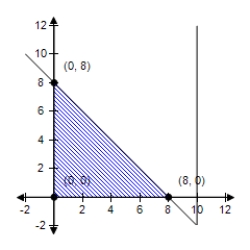 The constraint x ≤ 10 is extraneous.Minimum at (8,8): 8
The constraint x ≤ 10 is extraneous.Minimum at (8,8): 8
E)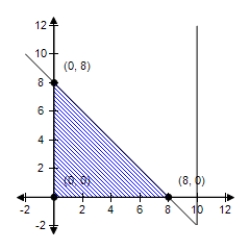 The constraint x ≤ 10 is extraneous.Minimum at (0,0): 0
The constraint x ≤ 10 is extraneous.Minimum at (0,0): 0
Objective function:
Z = -x + 2y
Constraints:
X ≥ 0
Y ≥ 0
X ≤ 10
X + y ≤ 8
A)
 The constraint x ≤ 10 is extraneous.Minimum at (0,8): 16
The constraint x ≤ 10 is extraneous.Minimum at (0,8): 16B)
 The constraint x ≤ 10 is extraneous.Minimum at (8,0): -8
The constraint x ≤ 10 is extraneous.Minimum at (8,0): -8C)
 The constraint x ≤ 10 is extraneous.No minimum.
The constraint x ≤ 10 is extraneous.No minimum.D)
 The constraint x ≤ 10 is extraneous.Minimum at (8,8): 8
The constraint x ≤ 10 is extraneous.Minimum at (8,8): 8E)
 The constraint x ≤ 10 is extraneous.Minimum at (0,0): 0
The constraint x ≤ 10 is extraneous.Minimum at (0,0): 0
فتح الحزمة
افتح القفل للوصول البطاقات البالغ عددها 50 في هذه المجموعة.
فتح الحزمة
k this deck
22
The linear programming problem has an unusual characteristic.Select a graph of the solution region for the problem and describe the unusual characteristic.Find the minimum value of the objective function (if possible)and where it occurs. ?
Objective function:
?
Z = 2.5x + y
?
Constraints:
?
X ? 0
Y ? 0
3x + 5y ? 15
?5x + 2y ? 10
?
A)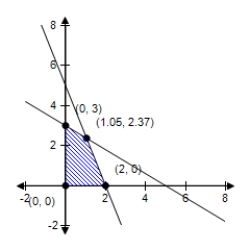 Minimum at (0,0): 0
Minimum at (0,0): 0
B)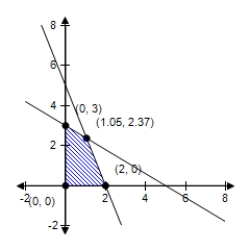 Minimum at : 5.00
Minimum at : 5.00
C)?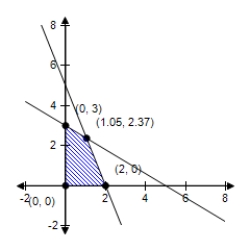 Minimum at : 2.63
Minimum at : 2.63
D)?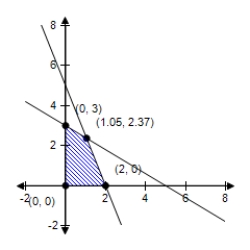 No minimum
No minimum
E)? Minimum at : 6.97
Minimum at : 6.97
Objective function:
?
Z = 2.5x + y
?
Constraints:
?
X ? 0
Y ? 0
3x + 5y ? 15
?5x + 2y ? 10
?
A)
 Minimum at (0,0): 0
Minimum at (0,0): 0B)
 Minimum at : 5.00
Minimum at : 5.00C)?
 Minimum at : 2.63
Minimum at : 2.63D)?
 No minimum
No minimumE)?
 Minimum at : 6.97
Minimum at : 6.97
فتح الحزمة
افتح القفل للوصول البطاقات البالغ عددها 50 في هذه المجموعة.
فتح الحزمة
k this deck
23
Find the maximum value of the objective function and where it occurs,subject to the constraints: ?
Objective function:
?
Z = x + 9y
?
Constraints:
?
X ? 0
Y ? 0
X + 4y ? 20
X + y ? 18
?2x + 2y ? 21
?
A)Maximum at (0,5): 45
B)Maximum at :
C)No maximum
D)Maximum at (0,0): 0
E)Maximum at :
Objective function:
?
Z = x + 9y
?
Constraints:
?
X ? 0
Y ? 0
X + 4y ? 20
X + y ? 18
?2x + 2y ? 21
?
A)Maximum at (0,5): 45
B)Maximum at :
C)No maximum
D)Maximum at (0,0): 0
E)Maximum at :

فتح الحزمة
افتح القفل للوصول البطاقات البالغ عددها 50 في هذه المجموعة.
فتح الحزمة
k this deck
24
According to automobile association of a country,on March 27,2009,the national average price per gallon of regular unleaded (86-octane)gasoline was $2.02,and the price of premium unleaded (91-octane)gasoline was $2.26.The cost of the blend of mid-grade unleaded gasoline (90-octane).Select a graph of the region determined by the constraints.
Constraints:
X ≥ 0
Y ≥ 0
X + y = 1
86x + 91y = 90
A)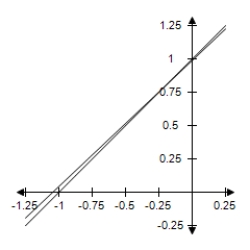
B)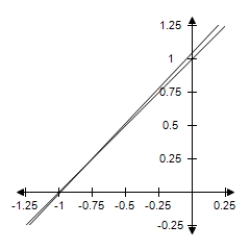
C)
D)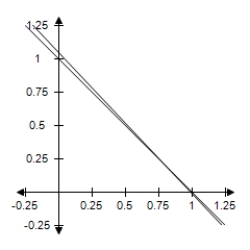
E)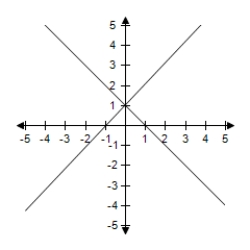
Constraints:
X ≥ 0
Y ≥ 0
X + y = 1
86x + 91y = 90
A)

B)

C)

D)

E)


فتح الحزمة
افتح القفل للوصول البطاقات البالغ عددها 50 في هذه المجموعة.
فتح الحزمة
k this deck
25
Find the minimum value of the objective function and where it occurs,subject to the constraints: ?
Objective function:
?
Z = x + 4y
?
Constraints:
?
X ? 0
Y ? 0
X + 4y ? 20
X + y ? 18
?2x + 2y ? 21
A)Minimum at (0,0): 0
B)Minimum at (0,5): 20
C)Minimum at (0,18): 72
D)Minimum at
E)No minimum
Objective function:
?
Z = x + 4y
?
Constraints:
?
X ? 0
Y ? 0
X + 4y ? 20
X + y ? 18
?2x + 2y ? 21
A)Minimum at (0,0): 0
B)Minimum at (0,5): 20
C)Minimum at (0,18): 72
D)Minimum at
E)No minimum

فتح الحزمة
افتح القفل للوصول البطاقات البالغ عددها 50 في هذه المجموعة.
فتح الحزمة
k this deck
26
The linear programming problem has an unusual characteristic.Select a graph of the solution region for the problem and describe the unusual characteristic.Find the minimum and maximum value of the objective function (if possible)and where it occurs.
Z = x + y
Constraints:
X ≥ 0
Y ≥ 0
-x + y ≤ 0
-5x + y ≥ 5
A)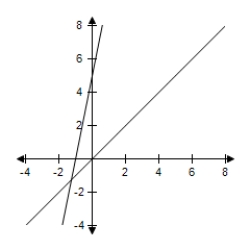 Minimum at (0,0): 0
Minimum at (0,0): 0
Maximum at (-1,0): -1
B)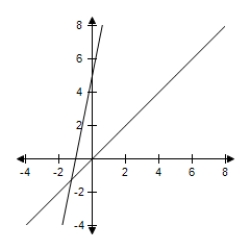 Minimum at (0,0): 0
Minimum at (0,0): 0
Maximum at (0,1): 1
C)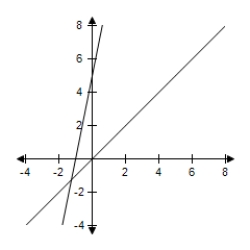 Minimum at (-1,0): -1
Minimum at (-1,0): -1
Maximum at (0,0): 0
D)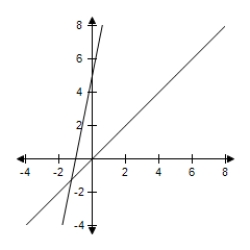 Minimum at (0,1): 1
Minimum at (0,1): 1
Maximum at (0,0): 0
E)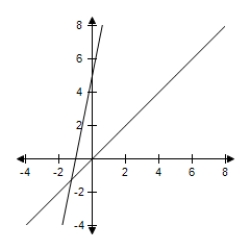 The feasible set is empty.
The feasible set is empty.
Z = x + y
Constraints:
X ≥ 0
Y ≥ 0
-x + y ≤ 0
-5x + y ≥ 5
A)
 Minimum at (0,0): 0
Minimum at (0,0): 0Maximum at (-1,0): -1
B)
 Minimum at (0,0): 0
Minimum at (0,0): 0Maximum at (0,1): 1
C)
 Minimum at (-1,0): -1
Minimum at (-1,0): -1Maximum at (0,0): 0
D)
 Minimum at (0,1): 1
Minimum at (0,1): 1Maximum at (0,0): 0
E)
 The feasible set is empty.
The feasible set is empty.
فتح الحزمة
افتح القفل للوصول البطاقات البالغ عددها 50 في هذه المجموعة.
فتح الحزمة
k this deck
27
The linear programming problem has an unusual characteristic.Select a graph of the solution region for the problem and describe the unusual characteristic.Find the maximum value of the objective function (if possible)and where it occurs.
Objective function:
Z = x + y
Constraints:
X ≥ 0
Y ≥ 0
-x + y ≤ 1
-x + 5y ≤ 7
A)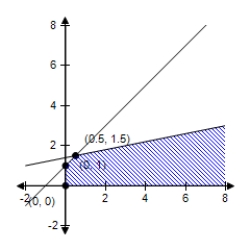 Maximum at (0.5,1.5): 2
Maximum at (0.5,1.5): 2
B)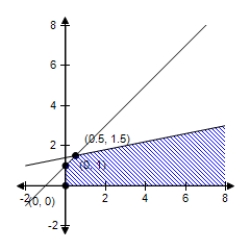 The region determined by the constraints is unbounded.For this unbounded region,there is no maximum value of z.
The region determined by the constraints is unbounded.For this unbounded region,there is no maximum value of z.
C)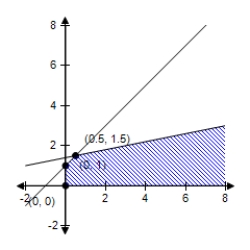 Maximum at (0,1): 1
Maximum at (0,1): 1
D)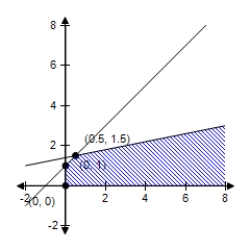 Maximum at (0,0): 0
Maximum at (0,0): 0
E)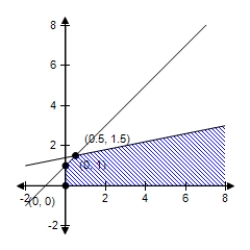 Maximum at (1.5,0.5): 2
Maximum at (1.5,0.5): 2
Objective function:
Z = x + y
Constraints:
X ≥ 0
Y ≥ 0
-x + y ≤ 1
-x + 5y ≤ 7
A)
 Maximum at (0.5,1.5): 2
Maximum at (0.5,1.5): 2B)
 The region determined by the constraints is unbounded.For this unbounded region,there is no maximum value of z.
The region determined by the constraints is unbounded.For this unbounded region,there is no maximum value of z.C)
 Maximum at (0,1): 1
Maximum at (0,1): 1D)
 Maximum at (0,0): 0
Maximum at (0,0): 0E)
 Maximum at (1.5,0.5): 2
Maximum at (1.5,0.5): 2
فتح الحزمة
افتح القفل للوصول البطاقات البالغ عددها 50 في هذه المجموعة.
فتح الحزمة
k this deck
28
Find the maximum value of the objective function and where it occurs,subject to the constraints: ?
Objective function:
?
Z = 5x + y
?
Constraints:
?
X ? 0
Y ? 0
X + 4y ? 20
X + y ? 18
?2x + 2y ? 21
?
A)Maximum at (0,5): 5
B)Maximum at :
C)Maximum at (0,0): 0
D)No maximum
E)Maximum at :
Objective function:
?
Z = 5x + y
?
Constraints:
?
X ? 0
Y ? 0
X + 4y ? 20
X + y ? 18
?2x + 2y ? 21
?
A)Maximum at (0,5): 5
B)Maximum at :
C)Maximum at (0,0): 0
D)No maximum
E)Maximum at :

فتح الحزمة
افتح القفل للوصول البطاقات البالغ عددها 50 في هذه المجموعة.
فتح الحزمة
k this deck
29
Find the minimum value of the objective function and where it occurs,subject to the constraints: ?
Objective function:
?
Z = 5x + 6y
?
Constraints:
?
X ? 0
Y ? 0
X + 4y ? 20
X + y ? 18
?2x + 2y ? 21
?
A)Minimum at (0,0): 0
B)Minimum at :
C)Minimum at : 19
D)Minimum at :
E)No minimum
Objective function:
?
Z = 5x + 6y
?
Constraints:
?
X ? 0
Y ? 0
X + 4y ? 20
X + y ? 18
?2x + 2y ? 21
?
A)Minimum at (0,0): 0
B)Minimum at :
C)Minimum at : 19
D)Minimum at :
E)No minimum

فتح الحزمة
افتح القفل للوصول البطاقات البالغ عددها 50 في هذه المجموعة.
فتح الحزمة
k this deck
30
According to automobile association of a country,on March 27,2009,the national average price per gallon of regular unleaded (87-octane)gasoline was $2.07,and the price of premium unleaded (90-octane)gasoline was $2.25.Write an objective function that models the cost of the blend of mid-grade unleaded gasoline (89-octane).
A)C = 2.25x - 2.07y
B)C = 87x + 89y
C)C = 2.07x + 2.25y
D)C = 87x + 90y
E)C = 90x + 89y
A)C = 2.25x - 2.07y
B)C = 87x + 89y
C)C = 2.07x + 2.25y
D)C = 87x + 90y
E)C = 90x + 89y

فتح الحزمة
افتح القفل للوصول البطاقات البالغ عددها 50 في هذه المجموعة.
فتح الحزمة
k this deck
31
Find the minimum value of the objective function and where it occurs,subject to the constraints: ?
Objective function:
?
Z = 8x + y
?
Constraints:
?
X ? 0
Y ? 0
X + 4y ? 20
X + y ? 18
?2x + 2y ? 21
?
A)Minimum at (0,0): 0
B)Minimum at (5,0): 40
C)Minimum at : 84
D)Minimum at (18,0): 144
E)No minimum
Objective function:
?
Z = 8x + y
?
Constraints:
?
X ? 0
Y ? 0
X + 4y ? 20
X + y ? 18
?2x + 2y ? 21
?
A)Minimum at (0,0): 0
B)Minimum at (5,0): 40
C)Minimum at : 84
D)Minimum at (18,0): 144
E)No minimum

فتح الحزمة
افتح القفل للوصول البطاقات البالغ عددها 50 في هذه المجموعة.
فتح الحزمة
k this deck
32
The linear programming problem has an unusual characteristic.Select a graph of the solution region for the problem and describe the unusual characteristic.Find the maximum value of the objective function (if possible)and where it occurs.
Objective function:
Z = -x + 3y
Constraints:
X ≥ 0
Y ≥ 0
X ≤ 10
X + y ≤ 7
A)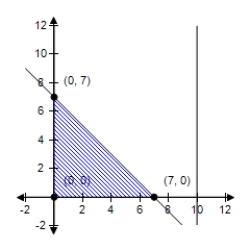 The constraint x ≤ 10 is extraneous.Maximum at (0,7): 21
The constraint x ≤ 10 is extraneous.Maximum at (0,7): 21
B)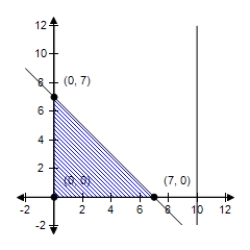 The constraint x ≤ 10 is extraneous.Maximum at (7,7): 14
The constraint x ≤ 10 is extraneous.Maximum at (7,7): 14
C)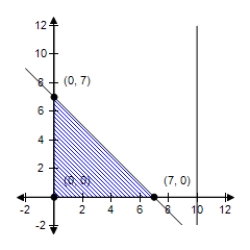 The constraint x ≤ 10 is extraneous.Maximum at (7,0): -7
The constraint x ≤ 10 is extraneous.Maximum at (7,0): -7
D)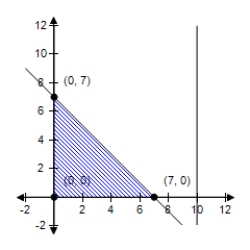 The constraint x ≤ 10 is extraneous.Maximum at (0,0): 0
The constraint x ≤ 10 is extraneous.Maximum at (0,0): 0
E)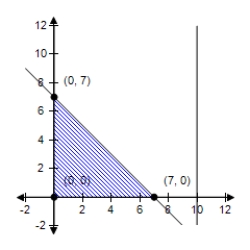 The constraint x ≤ 10 is extraneous.No maximum.
The constraint x ≤ 10 is extraneous.No maximum.
Objective function:
Z = -x + 3y
Constraints:
X ≥ 0
Y ≥ 0
X ≤ 10
X + y ≤ 7
A)
 The constraint x ≤ 10 is extraneous.Maximum at (0,7): 21
The constraint x ≤ 10 is extraneous.Maximum at (0,7): 21B)
 The constraint x ≤ 10 is extraneous.Maximum at (7,7): 14
The constraint x ≤ 10 is extraneous.Maximum at (7,7): 14C)
 The constraint x ≤ 10 is extraneous.Maximum at (7,0): -7
The constraint x ≤ 10 is extraneous.Maximum at (7,0): -7D)
 The constraint x ≤ 10 is extraneous.Maximum at (0,0): 0
The constraint x ≤ 10 is extraneous.Maximum at (0,0): 0E)
 The constraint x ≤ 10 is extraneous.No maximum.
The constraint x ≤ 10 is extraneous.No maximum.
فتح الحزمة
افتح القفل للوصول البطاقات البالغ عددها 50 في هذه المجموعة.
فتح الحزمة
k this deck
33
Find the maximum value of the objective function and where it occurs,subject to the constraints: ?
Objective function:
?
Z = 8x + 9y
?
Constraints:
?
X ? 0
Y ? 0
X + 4y ? 20
X + y ? 18
?2x + 2y ? 21
?
A)Maximum at :
B)Maximum at (0,0): 0
C)Maximum at :
D)Maximum at :
E)No maximum
Objective function:
?
Z = 8x + 9y
?
Constraints:
?
X ? 0
Y ? 0
X + 4y ? 20
X + y ? 18
?2x + 2y ? 21
?
A)Maximum at :
B)Maximum at (0,0): 0
C)Maximum at :
D)Maximum at :
E)No maximum

فتح الحزمة
افتح القفل للوصول البطاقات البالغ عددها 50 في هذه المجموعة.
فتح الحزمة
k this deck
34
The linear programming problem has an unusual characteristic.Select a graph of the solution region for the problem and describe the unusual characteristic.Find the minimum value of the objective function (if possible)and where it occurs.
Z = x + 3y
Constraints:
X ≥ 0
Y ≥ 0
X + 2y ≤ 4
2x + y ≤ 4
A)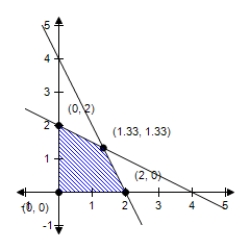 Minimum at (0,2): 6
Minimum at (0,2): 6
B) Minimum at (2,0): 2
Minimum at (2,0): 2
C)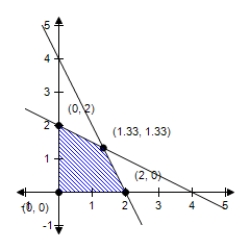 Minimum at (0,0): 0
Minimum at (0,0): 0
D)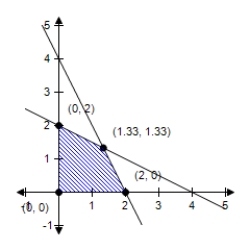 Minimum at (2,2): 8
Minimum at (2,2): 8
E)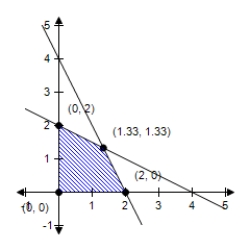 No minimum
No minimum
Z = x + 3y
Constraints:
X ≥ 0
Y ≥ 0
X + 2y ≤ 4
2x + y ≤ 4
A)
 Minimum at (0,2): 6
Minimum at (0,2): 6B)
 Minimum at (2,0): 2
Minimum at (2,0): 2C)
 Minimum at (0,0): 0
Minimum at (0,0): 0D)
 Minimum at (2,2): 8
Minimum at (2,2): 8E)
 No minimum
No minimum
فتح الحزمة
افتح القفل للوصول البطاقات البالغ عددها 50 في هذه المجموعة.
فتح الحزمة
k this deck
35
Find the minimum value of the objective function and where it occurs,subject to the constraints: ?
Objective function:
?
Z = 4x + 16y
?
Constraints:
?
X ? 0
Y ? 0
X + 4y ? 20
X + y ? 18
?2x + 2y ? 21
?
A)Minimum at :
B)Minimum at :
C)Minimum at (0,0): 0
D)Minimum at : 80
E)No minimum
Objective function:
?
Z = 4x + 16y
?
Constraints:
?
X ? 0
Y ? 0
X + 4y ? 20
X + y ? 18
?2x + 2y ? 21
?
A)Minimum at :
B)Minimum at :
C)Minimum at (0,0): 0
D)Minimum at : 80
E)No minimum

فتح الحزمة
افتح القفل للوصول البطاقات البالغ عددها 50 في هذه المجموعة.
فتح الحزمة
k this deck
36
According to automobile association of a country,on March 27,2009,the national average price per gallon of regular unleaded (85-octane)gasoline was $2.02,and the price of premium unleaded (93-octane)gasoline was $2.23.The cost of the blend of mid-grade unleaded gasoline (92-octane).Determine the constraints for the objective function.
A)x ≥ 0 y ≥ 0
X + y = 92
85x + 93y = 92
B)x ≥ 0 y ≥ 0
X + y = 1
85x + 93y = 92
C)x ≥ 0 y ≥ 0
X + y = 92
2)02x + 2.23y = 93
D)x ≥ 0 y ≥ 0
X + y = 92
2)02x + 2.23y = 92
E)x ≥ 0 y ≥ 0
X + y = 92
2)02x + 2.23y = 85
A)x ≥ 0 y ≥ 0
X + y = 92
85x + 93y = 92
B)x ≥ 0 y ≥ 0
X + y = 1
85x + 93y = 92
C)x ≥ 0 y ≥ 0
X + y = 92
2)02x + 2.23y = 93
D)x ≥ 0 y ≥ 0
X + y = 92
2)02x + 2.23y = 92
E)x ≥ 0 y ≥ 0
X + y = 92
2)02x + 2.23y = 85

فتح الحزمة
افتح القفل للوصول البطاقات البالغ عددها 50 في هذه المجموعة.
فتح الحزمة
k this deck
37
The linear programming problem has an unusual characteristic.Select a graph of the solution region for the problem and describe the unusual characteristic.Find the minimum value of the objective function (if possible)and where it occurs.
Z = x + y
Constraints:
X ≥ 0
Y ≥ 0
X + y ≤ 1
3x + y ≤ 6
A)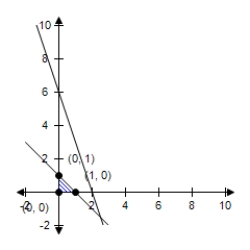 The constraint 3x + y ≤ 6 is extraneous.Minimum at (1,1): 9
The constraint 3x + y ≤ 6 is extraneous.Minimum at (1,1): 9
B)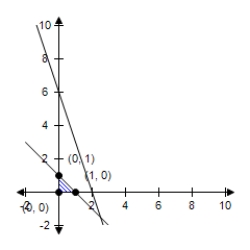 The constraint 3x + y ≤ 6 is extraneous.No minimum.
The constraint 3x + y ≤ 6 is extraneous.No minimum.
C)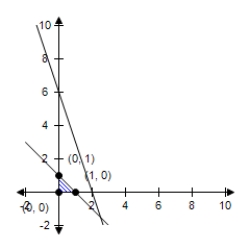 The constraint 3x + y ≤ 6 is extraneous.Minimum at (1,0): 4
The constraint 3x + y ≤ 6 is extraneous.Minimum at (1,0): 4
D) The constraint 3x + y ≤ 6 is extraneous.Minimum at (0,0): 0
The constraint 3x + y ≤ 6 is extraneous.Minimum at (0,0): 0
E)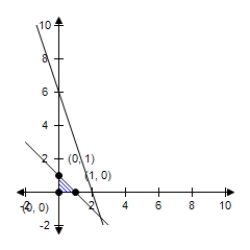 The constraint 3x + y ≤ 6 is extraneous.Minimum at (0,1): 5
The constraint 3x + y ≤ 6 is extraneous.Minimum at (0,1): 5
Z = x + y
Constraints:
X ≥ 0
Y ≥ 0
X + y ≤ 1
3x + y ≤ 6
A)
 The constraint 3x + y ≤ 6 is extraneous.Minimum at (1,1): 9
The constraint 3x + y ≤ 6 is extraneous.Minimum at (1,1): 9B)
 The constraint 3x + y ≤ 6 is extraneous.No minimum.
The constraint 3x + y ≤ 6 is extraneous.No minimum.C)
 The constraint 3x + y ≤ 6 is extraneous.Minimum at (1,0): 4
The constraint 3x + y ≤ 6 is extraneous.Minimum at (1,0): 4D)
 The constraint 3x + y ≤ 6 is extraneous.Minimum at (0,0): 0
The constraint 3x + y ≤ 6 is extraneous.Minimum at (0,0): 0E)
 The constraint 3x + y ≤ 6 is extraneous.Minimum at (0,1): 5
The constraint 3x + y ≤ 6 is extraneous.Minimum at (0,1): 5
فتح الحزمة
افتح القفل للوصول البطاقات البالغ عددها 50 في هذه المجموعة.
فتح الحزمة
k this deck
38
The linear programming problem has an unusual characteristic.Select a graph of the solution region for the problem and describe the unusual characteristic.Find the maximum value of the objective function (if possible)and where it occurs.
Z = 3x + 4y
Constraints:
X ≥ 0
Y ≥ 0
X + y ≤1
3x + y ≤ 6
A)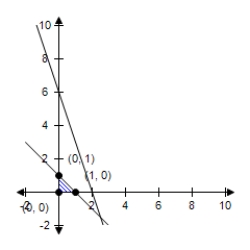 The constraint 3x + y ≤ 6 is extraneous.Maximum at (1,1): 7
The constraint 3x + y ≤ 6 is extraneous.Maximum at (1,1): 7
B)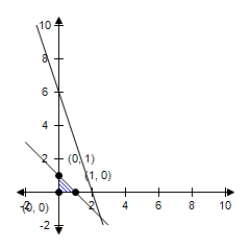 The constraint 3x + y ≤ 6 is extraneous.Maximum at (1,0): 3
The constraint 3x + y ≤ 6 is extraneous.Maximum at (1,0): 3
C)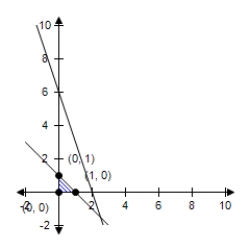 The constraint 3x + y ≤ 6 is extraneous.Maximum at (0,1): 4
The constraint 3x + y ≤ 6 is extraneous.Maximum at (0,1): 4
D)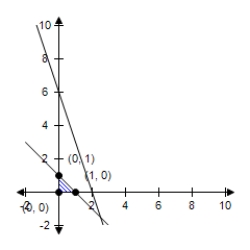 The constraint 3x + y ≤ 6 is extraneous.Maximum at (0,0): 0
The constraint 3x + y ≤ 6 is extraneous.Maximum at (0,0): 0
E)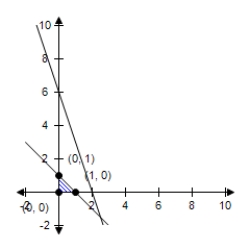 The constraint 3x + y ≤ 6 is extraneous.No maximum.
The constraint 3x + y ≤ 6 is extraneous.No maximum.
Z = 3x + 4y
Constraints:
X ≥ 0
Y ≥ 0
X + y ≤1
3x + y ≤ 6
A)
 The constraint 3x + y ≤ 6 is extraneous.Maximum at (1,1): 7
The constraint 3x + y ≤ 6 is extraneous.Maximum at (1,1): 7B)
 The constraint 3x + y ≤ 6 is extraneous.Maximum at (1,0): 3
The constraint 3x + y ≤ 6 is extraneous.Maximum at (1,0): 3C)
 The constraint 3x + y ≤ 6 is extraneous.Maximum at (0,1): 4
The constraint 3x + y ≤ 6 is extraneous.Maximum at (0,1): 4D)
 The constraint 3x + y ≤ 6 is extraneous.Maximum at (0,0): 0
The constraint 3x + y ≤ 6 is extraneous.Maximum at (0,0): 0E)
 The constraint 3x + y ≤ 6 is extraneous.No maximum.
The constraint 3x + y ≤ 6 is extraneous.No maximum.
فتح الحزمة
افتح القفل للوصول البطاقات البالغ عددها 50 في هذه المجموعة.
فتح الحزمة
k this deck
39
Find the maximum value of the objective function and where it occurs,subject to the constraints: ?
Objective function:
?
Z = 12x + 24y
?
Constraints:
?
X ? 0
Y ? 0
X + 4y ? 20
X + y ? 18
?2x + 2y ? 21
?
A)Maximum at (0,5): 120
B)Maximum at : 164
C)No maximum
D)Maximum at : 126
E)Maximum at (0,0): 0
Objective function:
?
Z = 12x + 24y
?
Constraints:
?
X ? 0
Y ? 0
X + 4y ? 20
X + y ? 18
?2x + 2y ? 21
?
A)Maximum at (0,5): 120
B)Maximum at : 164
C)No maximum
D)Maximum at : 126
E)Maximum at (0,0): 0

فتح الحزمة
افتح القفل للوصول البطاقات البالغ عددها 50 في هذه المجموعة.
فتح الحزمة
k this deck
40
The linear programming problem has an unusual characteristic.Select a graph of the solution region for the problem and describe the unusual characteristic.Find the minimum value of the objective function (if possible)and where it occurs.
Objective function:
Z = x + y
Constraints:
X ≥ 0
Y ≥ 0
-x + y ≤ 1
-x + 5y ≤ 7
A)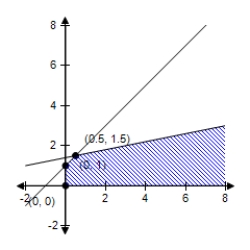 Minimum at (0,1): 1
Minimum at (0,1): 1
B)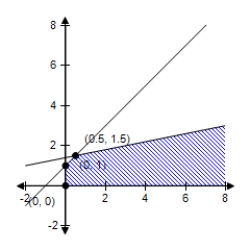 Minimum at (1.5,0.5): 2
Minimum at (1.5,0.5): 2
C)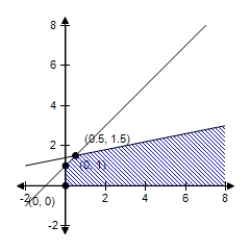 Minimum at (0.5,1.5): 2
Minimum at (0.5,1.5): 2
D)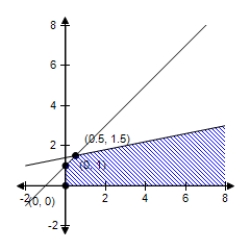 Minimum at (0,0): 0
Minimum at (0,0): 0
E)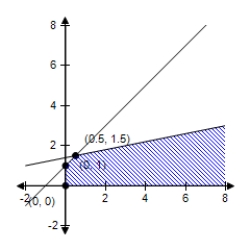 No minimum.
No minimum.
Objective function:
Z = x + y
Constraints:
X ≥ 0
Y ≥ 0
-x + y ≤ 1
-x + 5y ≤ 7
A)
 Minimum at (0,1): 1
Minimum at (0,1): 1B)
 Minimum at (1.5,0.5): 2
Minimum at (1.5,0.5): 2C)
 Minimum at (0.5,1.5): 2
Minimum at (0.5,1.5): 2D)
 Minimum at (0,0): 0
Minimum at (0,0): 0E)
 No minimum.
No minimum.
فتح الحزمة
افتح القفل للوصول البطاقات البالغ عددها 50 في هذه المجموعة.
فتح الحزمة
k this deck
41
An animal shelter mixes two brands of dog food.Brand X costs $29 per bag and contains two units of nutritional element A,two units of element B,and two units of element C.Brand Y costs $22 per bag and contains one unit of nutritional element A,nine units of element B,and three units of element C.The minimum required amounts of nutrients A,B,and C are 12 units,36 units,and 24 units,respectively.What is the optimal number of bags of each brand that should be mixed? What is the optimal cost?
A)9 bags of brand X 2 bags of brand Y
Optimal cost: $305
B)6 bags of brand X 3 bags of brand Y
Optimal cost: $264
C)2 bags of brand X 9 bags of brand Y
Optimal cost: $522
D)18 bags of brand X 12 bags of brand Y
Optimal cost: $786
E)3 bags of brand X 6 bags of brand Y
Optimal cost: $219
A)9 bags of brand X 2 bags of brand Y
Optimal cost: $305
B)6 bags of brand X 3 bags of brand Y
Optimal cost: $264
C)2 bags of brand X 9 bags of brand Y
Optimal cost: $522
D)18 bags of brand X 12 bags of brand Y
Optimal cost: $786
E)3 bags of brand X 6 bags of brand Y
Optimal cost: $219

فتح الحزمة
افتح القفل للوصول البطاقات البالغ عددها 50 في هذه المجموعة.
فتح الحزمة
k this deck
42
A manufacturer produces two models of elliptical cross-training exercise machines. The times for assembling,finishing,and packaging model X are 3 hours,3 hours,and 0.8 hour,respectively.The times for model Y are 4 hours,2.5 hours,and 0.4 hour.The total times available for assembling,finishing,and packaging are 6000 hours,4200 hours,and 950 hours,respectively.The profits per unit are $200 for model X and $275 for model Y.What is the optimal production level for each model? What is the optimal profit?
A)6000 units of model X 950 units of model Y
Optimal profit: $1,461,250
B)950 units of model X 6000 units of model Y
Optimal profit: $1,840,000
C)400 units of model X 1200 units of model Y
Optimal profit: $410,000
D)950 units of model X 4200 units of model Y
Optimal profit: $1,345,000
E)4200 units of model X 950 units of model Y
Optimal profit: $1,101,250
A)6000 units of model X 950 units of model Y
Optimal profit: $1,461,250
B)950 units of model X 6000 units of model Y
Optimal profit: $1,840,000
C)400 units of model X 1200 units of model Y
Optimal profit: $410,000
D)950 units of model X 4200 units of model Y
Optimal profit: $1,345,000
E)4200 units of model X 950 units of model Y
Optimal profit: $1,101,250

فتح الحزمة
افتح القفل للوصول البطاقات البالغ عددها 50 في هذه المجموعة.
فتح الحزمة
k this deck
43
An accounting firm has 780 hours of staff time and 272 hours of reviewing time available each week.The firm charges $1000 for an audit and $350 for a tax return.Each audit requires 60 hours of staff time and 16 hours of review time.Each tax return requires 10 hours of staff time and 4 hours of review time.What numbers of audits and tax returns will yield an optimal revenue? What is the optimal revenue?
A)0 audits 13 tax returns
Optimal revenue: $16,800
B)48 audits 5 tax returns
Optimal revenue: $21,800
C)0 audits 65 tax returns
Optimal revenue: $10,000
D)5 audits 48 tax returns
Optimal revenue: $21,800
E)10 audits 10 tax returns
Optimal revenue: $11,750
A)0 audits 13 tax returns
Optimal revenue: $16,800
B)48 audits 5 tax returns
Optimal revenue: $21,800
C)0 audits 65 tax returns
Optimal revenue: $10,000
D)5 audits 48 tax returns
Optimal revenue: $21,800
E)10 audits 10 tax returns
Optimal revenue: $11,750

فتح الحزمة
افتح القفل للوصول البطاقات البالغ عددها 50 في هذه المجموعة.
فتح الحزمة
k this deck
44
A humanitarian agency can use two models of vehicles for a refugee rescue mission.Each model A vehicle costs $1000 and each model B vehicle costs $1500.Mission strategies and objectives indicate the following constraints.A total of at least 20 vehicles must be used.A model A vehicle can hold 45 boxes of supplies.A model B vehicle can hold 24 boxes of supplies.The agency must deliver at least 690 boxes of supplies to the refugee camp.A model A vehicle can hold 17 refugees.A model B vehicle can hold 35 refugees.The agency must rescue at least 520 refugees.What is the optimal number of vehicles of each model that should be used? What is the optimal cost?
A)30 model A vehicles 32 model B vehicles
Optimal cost: $78,000
B)20 model A vehicles 20 model B vehicles
Optimal cost: $50,000
C)10 model A vehicles 10 model B vehicles
Optimal cost: $25,000
D)45 model A vehicles 30 model B vehicles
Optimal cost: $90,000
E)20 model A vehicles 32 model B vehicles
Optimal cost: $68,000
A)30 model A vehicles 32 model B vehicles
Optimal cost: $78,000
B)20 model A vehicles 20 model B vehicles
Optimal cost: $50,000
C)10 model A vehicles 10 model B vehicles
Optimal cost: $25,000
D)45 model A vehicles 30 model B vehicles
Optimal cost: $90,000
E)20 model A vehicles 32 model B vehicles
Optimal cost: $68,000

فتح الحزمة
افتح القفل للوصول البطاقات البالغ عددها 50 في هذه المجموعة.
فتح الحزمة
k this deck
45
An accounting firm has 780 hours of staff time and 272 hours of reviewing time available each week.The firm charges $1700 for an audit and $410 for a tax return.Each audit requires 60 hours of staff time and 16 hours of review time.Each tax return requires 10 hours of staff time and 4 hours of review time.What numbers of audits and tax returns will yield an optimal revenue? What is the optimal revenue?
A)0 audit 65 tax returns
Optimal revenue: $6,560
B)5 audits 48 tax return
Optimal revenue: $28,180
C)16 audits 0 tax return
Optimal revenue: $27,200
D)10 audits 10 tax returns
Optimal revenue: $21,100
E)13 audit 0 tax returns
Optimal revenue: $28,180
A)0 audit 65 tax returns
Optimal revenue: $6,560
B)5 audits 48 tax return
Optimal revenue: $28,180
C)16 audits 0 tax return
Optimal revenue: $27,200
D)10 audits 10 tax returns
Optimal revenue: $21,100
E)13 audit 0 tax returns
Optimal revenue: $28,180

فتح الحزمة
افتح القفل للوصول البطاقات البالغ عددها 50 في هذه المجموعة.
فتح الحزمة
k this deck
46
A merchant plans to sell two models of MP3 players at prices of $225 and $250.The $225 model yields a profit of $30 per unit and the $250 model yields a profit of $31 per unit.The merchant estimates that the total monthly demand will not exceed 280units.The merchant does not want to invest more than $55,776 in inventory for these products.What is the optimal inventory level for each model? What is the optimal profit?
A)231 units of the $225 model 49 units of the $250 model
Optimal profit: $8,449
B)225 units of the $225 model 30 units of the $250 model
Optimal profit: $7,680
C)250 units of the $225 model 31 units of the $250 model
Optimal profit: $8,461
D)275 units of the $225 model 30 units of the $250 model
Optimal profit: $9,180
E)275 units of the $225 model 31 units of the $250 model
Optimal profit: $9,211
A)231 units of the $225 model 49 units of the $250 model
Optimal profit: $8,449
B)225 units of the $225 model 30 units of the $250 model
Optimal profit: $7,680
C)250 units of the $225 model 31 units of the $250 model
Optimal profit: $8,461
D)275 units of the $225 model 30 units of the $250 model
Optimal profit: $9,180
E)275 units of the $225 model 31 units of the $250 model
Optimal profit: $9,211

فتح الحزمة
افتح القفل للوصول البطاقات البالغ عددها 50 في هذه المجموعة.
فتح الحزمة
k this deck
47
Find the minimum and maximum values of the objective function and where it occurs,subject to the indicated constraints. Objective function:
Z = 3x + 4y
Constraints: ?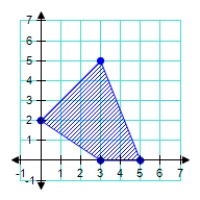
A)minimum = 8 at (0,2);maximum = 29 at (3,5)
B)minimum = -11 at (3,5);maximum = 15 at (5,0)
C)minimum = 8 at (0,2);maximum = 27 at (3,5)
D)minimum = 0 at (0,0);maximum = 29 at (3,5)
E)minimum = 9 at (3,0);maximum = 15 at (5,0)
Z = 3x + 4y
Constraints: ?

A)minimum = 8 at (0,2);maximum = 29 at (3,5)
B)minimum = -11 at (3,5);maximum = 15 at (5,0)
C)minimum = 8 at (0,2);maximum = 27 at (3,5)
D)minimum = 0 at (0,0);maximum = 29 at (3,5)
E)minimum = 9 at (3,0);maximum = 15 at (5,0)

فتح الحزمة
افتح القفل للوصول البطاقات البالغ عددها 50 في هذه المجموعة.
فتح الحزمة
k this deck
48
Find the maximum value of the objective function and where it occurs,subject to the indicated constraints.(You should graph the feasible solutions on the grid below before you attempt to find the minimum and maximum values. ) Objective function:
Z = 6x - 7y
Constraints: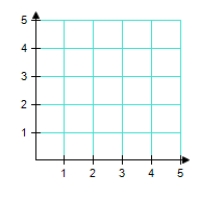
A)maximum = 24 at (4,0)
B)The maximum is unbounded.
C)maximum = 35 at (0,5)
D)maximum = 12 at (2,0)
E)There is no maximum.The feasable solution set is empty.
Z = 6x - 7y
Constraints:

A)maximum = 24 at (4,0)
B)The maximum is unbounded.
C)maximum = 35 at (0,5)
D)maximum = 12 at (2,0)
E)There is no maximum.The feasable solution set is empty.

فتح الحزمة
افتح القفل للوصول البطاقات البالغ عددها 50 في هذه المجموعة.
فتح الحزمة
k this deck
49
An investor has $450,000 to invest in two types of investments.Type A pays 6% annually and type B pays 7% annually.To have a well-balanced portfolio,the investor imposes the following conditions.At least one-third of the total portfolio is to be allocated to type A investments and at least one-third of the portfolio is to be allocated to type B investments.What is the optimal amount that should be invested in each investment? 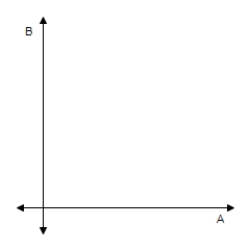
A)$160,000 in type A (6%),$290,000 in type B (7%)
B)$0 in type A (6%),$450,000 in type B (7%)
C)$450,000 in type A (6%),$0 in type B (7%)
D)$300,000 in type A (6%),$150,000 in type B (7%)
E)$150,000 in type A (6%),$300,000 in type B (7%)

A)$160,000 in type A (6%),$290,000 in type B (7%)
B)$0 in type A (6%),$450,000 in type B (7%)
C)$450,000 in type A (6%),$0 in type B (7%)
D)$300,000 in type A (6%),$150,000 in type B (7%)
E)$150,000 in type A (6%),$300,000 in type B (7%)

فتح الحزمة
افتح القفل للوصول البطاقات البالغ عددها 50 في هذه المجموعة.
فتح الحزمة
k this deck
50
According to automobile association of a country,on March 27,2009,the national average price per gallon of regular unleaded (88-octane)gasoline was $2.08,and the price of premium unleaded (93-octane)gasoline was $2.27.Write an objective function that models the cost of the blend of mid-grade unleaded gasoline (89-octane).What is the optimal cost?
A)$2.23/gal
B)$1.66/gal
C)$2.12/gal
D)$3.12/gal
E)$3.23/gal
A)$2.23/gal
B)$1.66/gal
C)$2.12/gal
D)$3.12/gal
E)$3.23/gal

فتح الحزمة
افتح القفل للوصول البطاقات البالغ عددها 50 في هذه المجموعة.
فتح الحزمة
k this deck








